The FAB world is once again abuzz with phrases like ‘open meta’ and ‘mid range’, and rumors of the rise of decks that adapt to game situations. Player skill level continues to increase, and there seems to be a surge of deck builders looking to assess ‘above curve’ value in their builds. With the recent ban and suspended list keeping some of the recently popular linear strategies at bay, Dorinthea Ironsong has begun to carve out a place for herself.
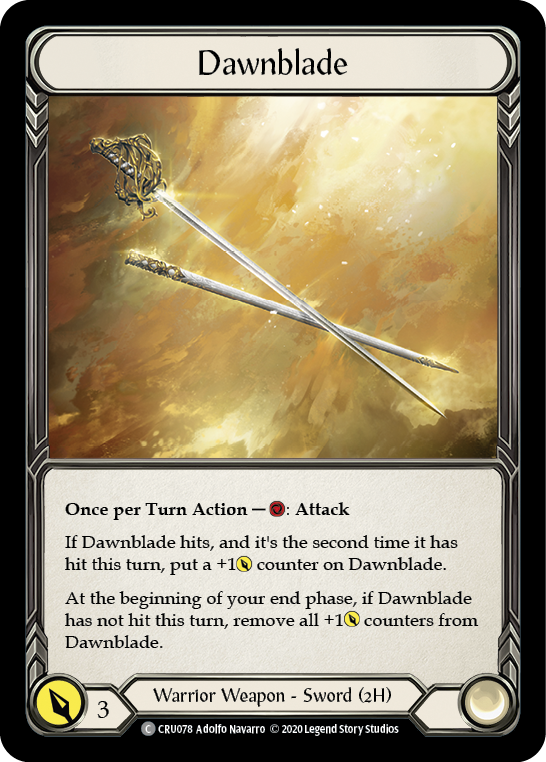
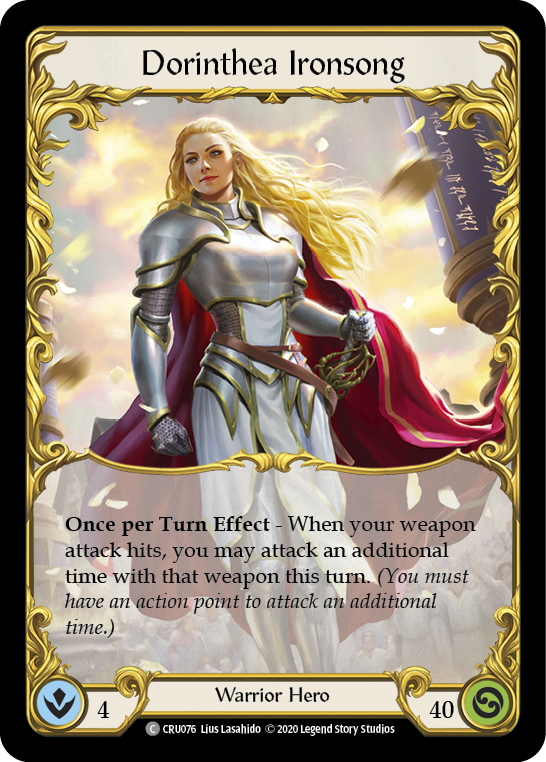
Most decks find value in either the attacking end of the spectrum or the blocking end, but Dori finds herself in the middle. This is known as ‘midrange’. Her cards are flexible and do not push her heavily into either the attacking or blocking strategies. From an equipment perspective, Dori has the proverbial ‘fridge’ to block with, and nearly all cards in the deck block for 3, making Dori one of stronger non-Guardian heroes when it comes to defense.
Although Dori’s attacking strategy is not pushed as heavily as Ninjas or Runeblades, this sword-wielding heroine operates on an axis that most heroes cannot. Her cards support both a proactive and reactive gameplan, and can be tuned to focus on one of these gameplans more heavily depending on how it's built.
In this article, we’ll look at a couple key cards that support either strategy.
Proactive Play
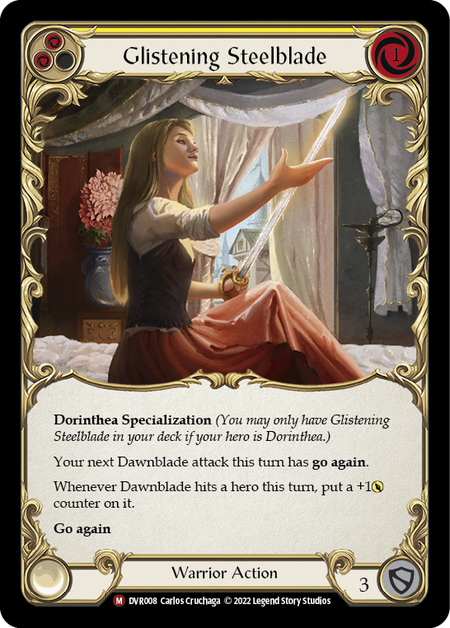
To get an idea of the power of Glistening Steelblade - the newest addition to Dori's toolkit - let’s consider a turn where the opponent chooses not to block, and allows us to get the full value from it.
The hand:
- Glistening Steelblade
- Out for Blood (R)
- Ironsong Response (R)
- A blue pitch card
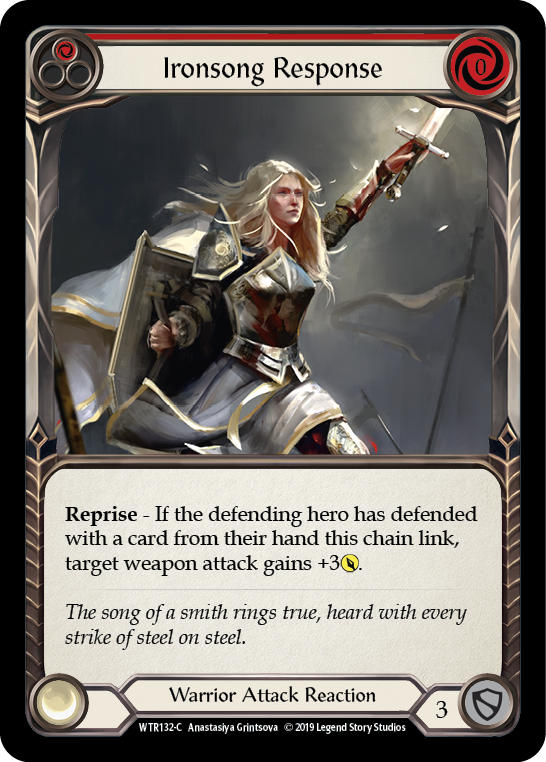
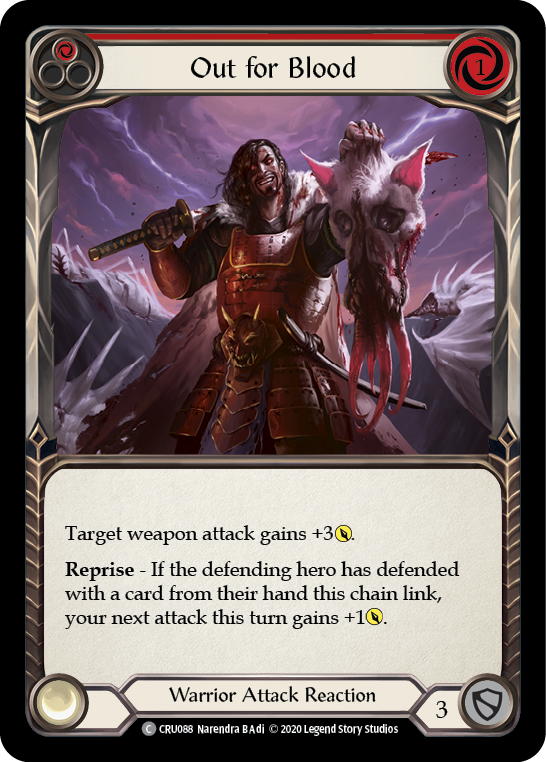
Let's follow some possible pathways through the turn.
Glistening Steelblade > pitch blue > Dawnblade for 3 > Dawnblade for 4
(Out for Blood and Ironsong Response remain in hand.)
Damage calculation:
3 + 4 + 2 counters on the next turn = 9, divided by 2 cards played = 4.5 value per card
4.5 is excellent value - and is higher than the value from something like a two-card hand with Enlightened Strike, which is 3.5 value per card. But the opponent is unlikely to let this turn happen unfettered, so let’s see what happens when we need to deal with blocks.
If the opponent blocks the first card and you play the Ironsong Response:
6 + 4 + 2 = 12 / 3 cards played = 4 value per card
If the opponent blocks the first card and you play the Out for Blood:
6 + 5 + 2 = 13 / 4 cards played = 3.25 value per card
As you might have assumed, our value drops when we’re forced to play more of our cards. While Glistening helps our proactive strategy when the opponent chooses not to block, examples two and three show us how quickly our value degrades when we need to play other cards to deal with blocks.
What if the opponent blocks out the first swing completely and you’re unable to use Dori’s ability to swing again? Good question- and that leads us to the reaction strategy.
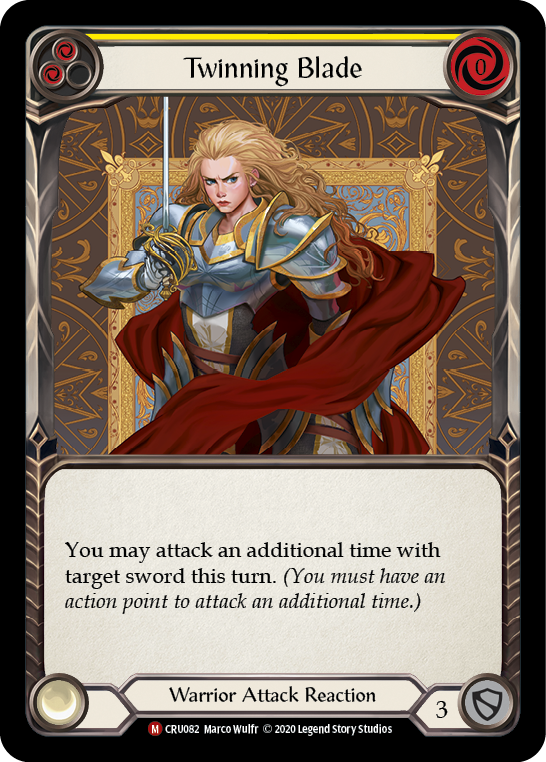
Most of Dori’s opponents have learned that a good way to dead end one of her turns is to lay down a full hand of blocks in front of the first Dawnblade attack. Twinning Blade is a card that lets us swing Dawnblade again without having to hit, which gets around the opponent’s wall of cards in these scenarios. Let’s evaluate the same turn, but with Twinning in arsenal.
Glistening Steelblade > pitch blue > Dawnblade for 3 > Twinning from arsenal > Dawnblade for 3
(Out for Blood and Ironsong Response remain in hand)
Damage calculation:
3 + 3 + 1 counter on the next turn = 7 / divided by 3 cards played = 2.33 value per card
If the opponent blocked out using all 4 of their cards, you could add the value from them using one more card than you for the turn. This would change the calculation to be 11 / 3 = 3.66, or 7 / 2 = 3.5 depending on how you prefer your math. The counter-argument to this is that we didn’t use all the cards in our hand – we’re still holding the Out for Blood and Ironsong in hand. Even if we arsenal one card, our turn is still inefficient by one card, just as the opponent was, so the calculation remains 2.33 per card.
But it is an interesting point. Notice how Dorinthea’s cards are valued higher based on what the opponent does. A potential downside of Dori is that it requires the opponent to make a less efficient choice in order for her cards to be ‘on rate’.
Can we get more value out of Twinning if we put more emphasis on a reaction-heavy strategy?
Reactive Play
Let’s strip down this turn even more, by removing the Glistening Steelblade and adding a reaction that gives go again instead, like Glint the Quicksilver.
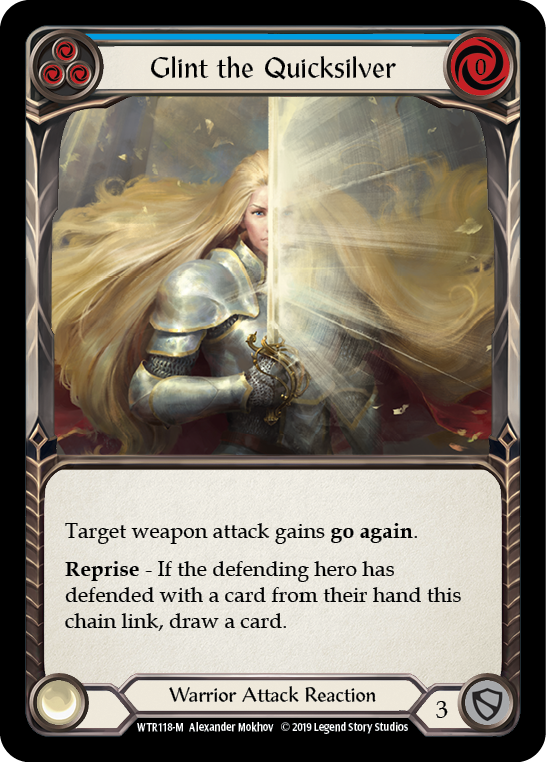
Dawnblade for 3 > pitch blue > Glint the Quicksilver > Twinning from arsenal > Dawnblade for 3
(Out for Blood and Ironsong Response remain in hand, plus a card we draw off Glint)
Damage calculation:
3 + 3 + 1 counter on the next turn = 7 / divided by 3 cards played = 2.33 value per card
...but this time we are one card ahead of the opponent, since we drew a card from Glint’s reprise ability. This makes our new calculation equal 7 / 2 = 3.5 like we mentioned before, which gets us closer to being on rate.
Another way we could have boiled this down is if we had said Twinning gets us a second swing, so the value of Twinning must equal the value of the second swing minus the cost of the go again to get there. This also means that, if we have counters on Dawnblade when we begin the turn and are able to draw off Glint, then the value of Twinning equals the damage of Dawnblade plus any counters on it.
If Dawnblade has one counter, then the value per card if we calculate damage presented with Glint and Twinning across two swings is 4. (8 / 2 = 4) If Dawnblade has two counters then the value would be 5, and so on. Drawing a card off Glint’s Reprise effect enables the average value of the cards played during the turn to increase - which can be said for any turn involving card draw.
Finding Balance
If Twinning Blade’s value is derived from the other cards played with it, how can we ensure it will be on rate? In short, you can’t. The value might come close on a turn where you play a red Hit and Run before the second swing and the opponent blocks it out, since you can equate the three damage from Hit and Run as close to the 4 damage you’d get from an additional on-rate card… but even then it's a stretch rationalization when 3 is already below rate. Twinning is best paired with Glint in my opinion, and is one of the best reaction pairs Dorinthea has to offer.
Thinking back to our proactive strategy, how might we apply this example of card advantage to better our efforts on the proactive front? Let’s consider one more example using Dori’s other power cards.
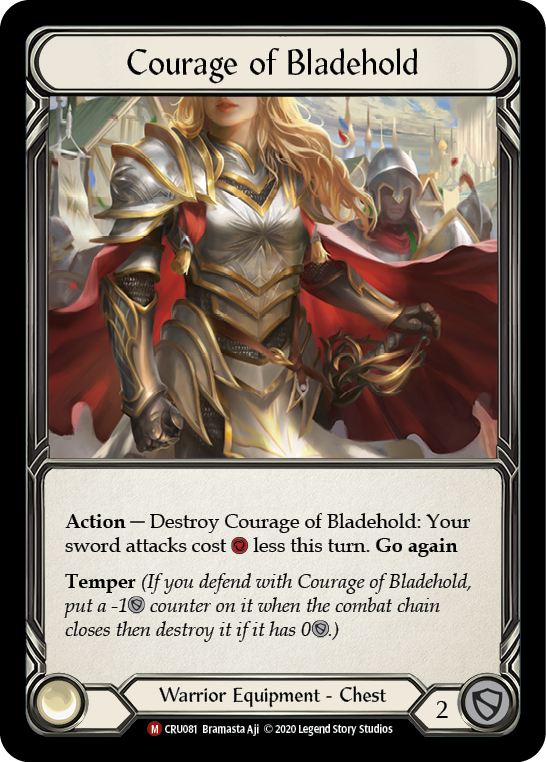
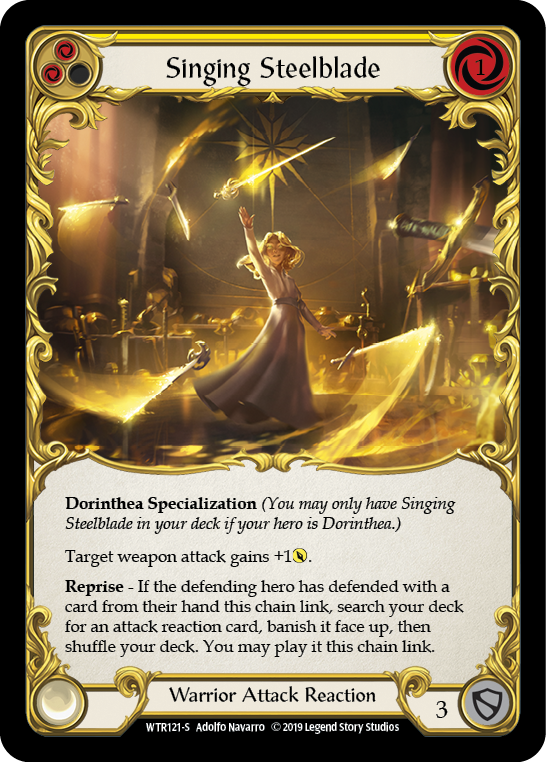
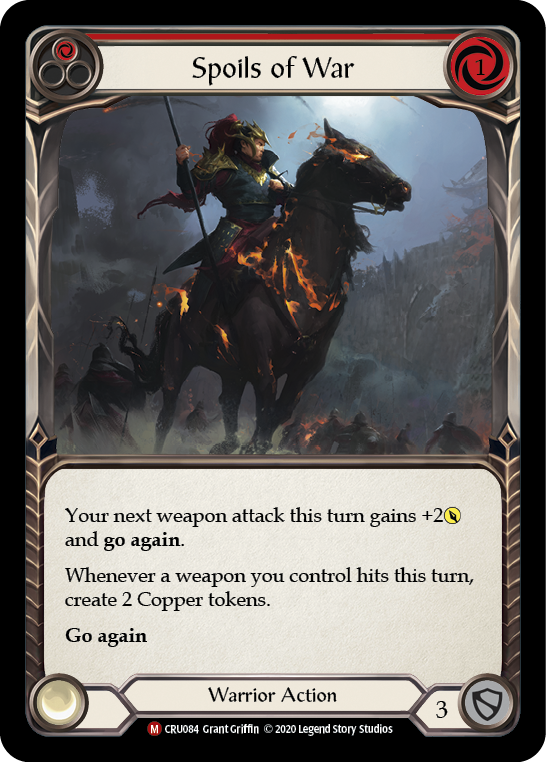
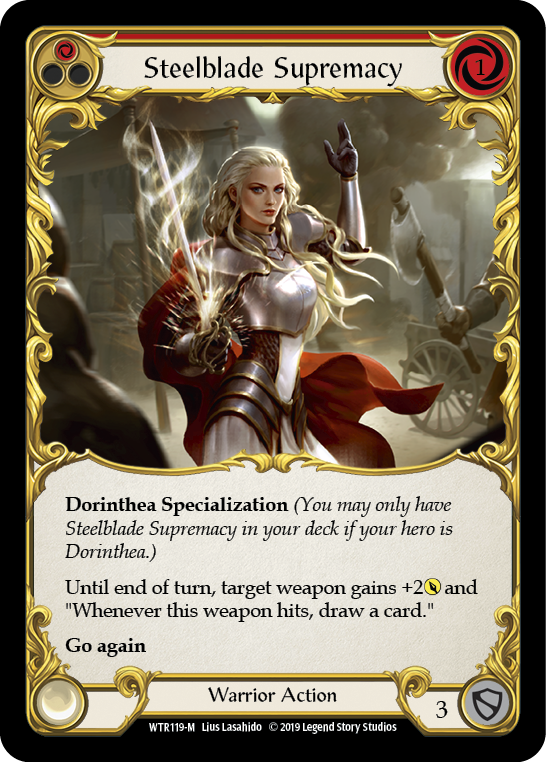
The Hand:
- Steelblade Supremacy
- Singing Steelblade
- Spoils of War
- A blue pitch card
- Ironsong Response (r) in arsenal
Courage of Bladehold > pitch blue > Steelblade Supremacy > Spoils of War > Dawnblade for 7 (3+2+2) > Singing Steelblade > Ironsong red > Ironsong red > Dawnblade for 5
Damage calculation:
7+1+3+3+5+1 counter next turn = 20 damage / (7-2) 5 cards used = 4 value per card
Cracking Courage of Bladehold and playing two power cards will likely signal to your opponent that your turn is about to be huge and they need to shut it down. If they block out with their whole hand for 12, you can get over the top with Singing Steelblade and a couple pumps, draw a card off Supremacy and swing again for 5, drawing a second card and gaining a counter for the next turn when it hits. Since we draw twice from Supremacy’s ability, we can subtract two cards from the total of 7 cards used, to make our total value per card 20 damage divided by 5 cards used, which is 4 value per card.
This is one of the best turns you can have with Dori, and becomes easier to achieve if Dawnblade has counters. Even though this is a dream turn that requires setup, it exemplifies the importance of card advantage in Dori builds and playstyle.
So What Does All This Mean?
First and foremost, it means we should be very selective about the cards we choose when deckbuilding. We want our cards to be on rate, which it seems Dori does not come by easily. It also means we should be placing higher importance on cards with net gains in card advantage, like Steelblade Supremacy and Glint the Quicksilver.
Ultimately it means neither the proactive nor reactive strategies should be focused on without considering the other. We need to be cautious when adding below rate cards with on-hit abilities. We need to be cautious when relying on cards that derive their value from the other cards played alongside them.
Card values will always depend on a mix of your playstyle and how the opponent is blocking, so it's hard to nail down a definite value that remains consistent in all cases. But I urge you to think twice about cards like Twinning Blade and Glistening Steelblade, and plan out the ways you might derive value from them. If the value comes up short, cut ‘em.
Spatium by Keys of Moon | Music promoted by Chosic | Attribution 4.0 International (CC BY 4.0)





